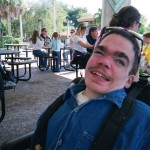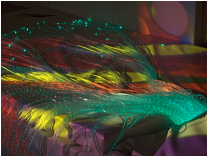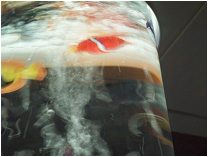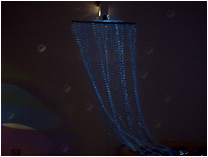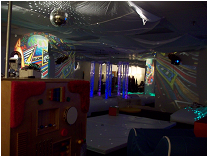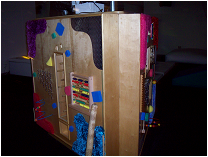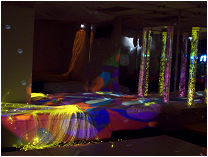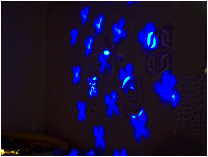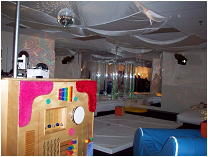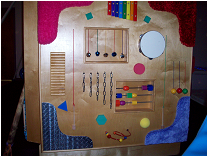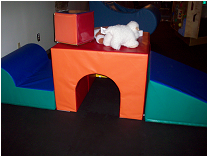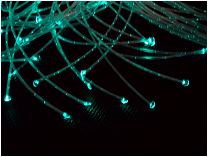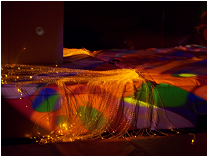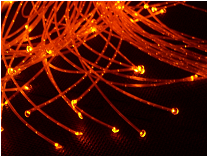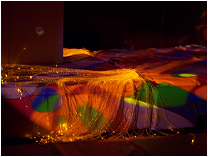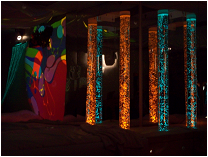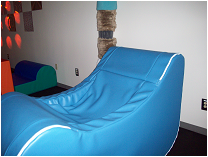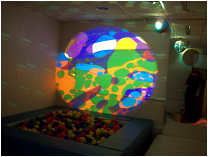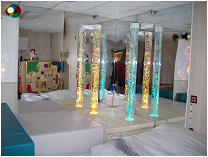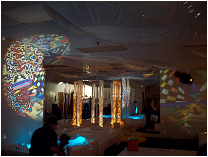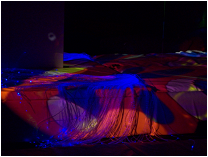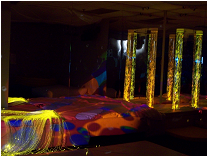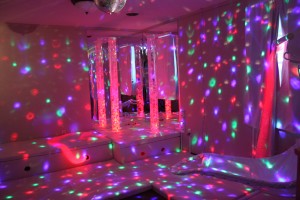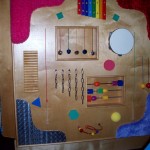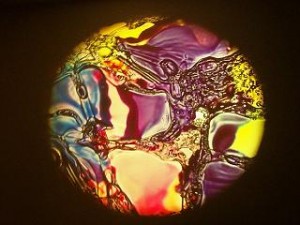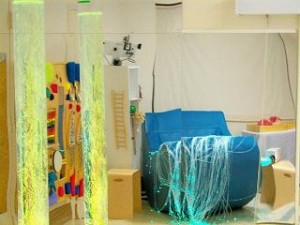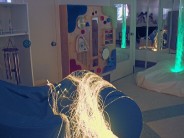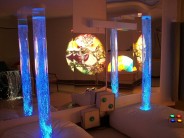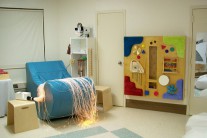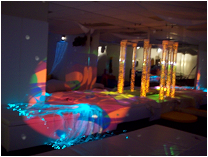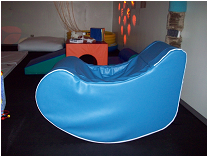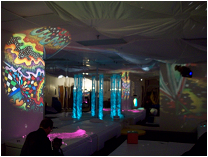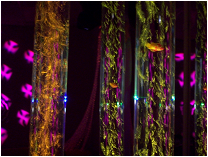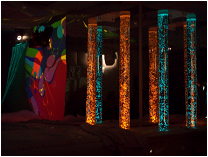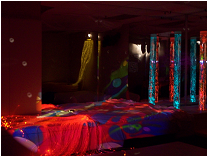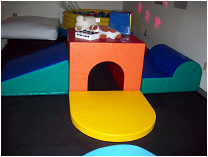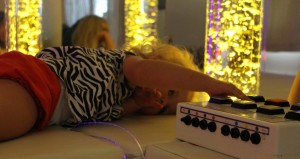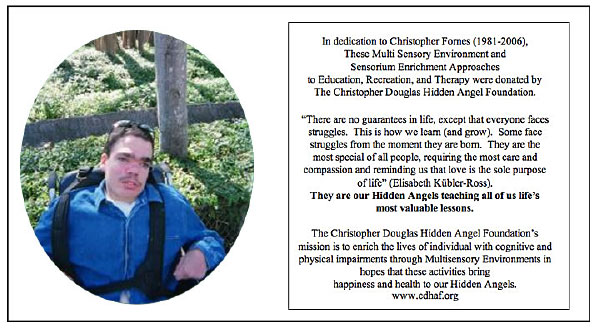“There are no guarantees in life, except that everyone faces struggles. This is how we learn (and grow). Some face struggles from the moment they are born. They are the most special of all people, requiring the most care and compassion and reminding us that love is the sole purpose of life.”– Elisabeth Kübler-Ross
These are our Hidden Angels – teaching all of us life’s most valuable lessons.
Therapy in a multisensory environment, a room that soothes
Source Journal Sentinel
June 25, 2012 – Six-year-old John Burks sits near a padded white mat in a white-walled room, waiting for it to be transformed into his own private party space.
Streams of red simultaneously gush through a pair of ceiling-to-floor vertical bubble tubes on each side of the room. A pile of fiber optic strands turn red and another cluster of green strands hang from the wall. Geometric patterns twirl and spin into endless kaleidoscope shapes. A silver disco ball glitters in the air as “Mr. Blue Sky” plays in the background.
John sits mesmerized as the room bursts into color. Initially oblivious to the music, he starts bobbing his head once the track switches to “Strange Magic,” another song from the Electric Light Orchestra.
This is all part of therapy designed for children and adults with developmental and cognitive disabilities at the Milwaukee Center for Independence. This room, called a multisensory environment, is a controlled sensory input concept developed in the 1960s by American psychologists. They appropriately called rooms like this “sensory cafeterias” to help individuals with attention, memory, learning, sensory or physical disorders.
Some of the children who benefit from being in this controlled environment have autism, cognitive disabilities, Down syndrome, cerebral palsy or brain injuries.
“Participating in the multisensory environment gives them a way to engage in an environment and have control over the choices they’re making,” said Nancy Pickett, director of the center’s leisure, inclusion, fun and experiences, or L.I.F.E., program.
Pickett said many kids come in with overexcited systems, so giving them choices helps with brain organization.
The room provides auditory, tactile and visual stimulation in a safe, controlled environment, said Pickett, citing that the average body has 300 different touches in a 30-minute period, which may bombard or overload people with sensitive sensory systems.
Each day, about five to seven children and adults use the center’s therapy room, which opened in February. The average child who gets multisensory environment therapy is between 3 and 11 years old. Adults with developmental and physical disabilities between the ages of 18 and 60 also are part of the clientele.
“This is a stepping point to full-time employment,” said Pickett, pointing out that some adults, especially ones who grew up in institutions, use the therapy as they transition into a community.
Personalized sensory session
Sullivan “Sully” Ustruck, 5, who was diagnosed with a severe seizure disorder last fall and has had multiple brain surgeries, is wheeled into the room. His physical therapist helps him stand and walks him over to the bubble tubes.
His therapy sessions, usually three times a week, were interrupted by a recent seven-week hospitalization. He started multisensory environment therapy earlier this year with physical therapist Kathryn Cabral.
Sully does not use his right arm and left foot as much as his other limbs. Cabral is trying to get him to use the right arm, since he was right-handed before his diagnosis. Along with the multisensory environment he also is receiving physical, speech and neurological music therapy.
His mother, Melissa Ustruck, said his providers are good with communicating suggestions and notes about his therapy progress. “He’s a tough case. There’s no definitive reason why Sully is the way he is with all the seizures,” she said.
Cabral helps him walk back to the wheelchair. “This is his journey. This is what he has to do to get there.”
An exploratory environment
Kids can play with wheels and a cymbal attached to a board. Although this room is designed for self-direction, therapists push buttons for younger kids to slowly change their environment, coaching them to take risks in a safe place.
John’s occupational therapist, Sabrin Rizk, starts off with red and orange tones streaming into items so he feels alert after a nap. He’s being given therapy because of medical issues from earlier in his childhood.
The multisensory room is also known as the “Snoezelen room,” combining Dutch words meaning to explore and relax. Both of these terms play out in the room as individuals tend to explore their surroundings and wind down after being stimulated.
“Environments like this have shown to improve alertness and arousal and attention and in transferring skills he uses here to the classroom,” Rizk said.
Some children and adults need stimulation of their sense and awareness of body position and movement. They sit in a pool of balls for deep pressure, along with choosing a heated water bed and a vibrating mattress. John gravitates toward the pool of balls and playfully tosses one in the air.
Slowly, the brighter colors change from red to purple to more relaxing, soothing greens and blues.
Even the way in which things are turned on and off has a sense of organization, with a therapist slowly shutting everything off in reverse order.
Kris Barnekow, a professor in the department of occupational science and technology at the University of Wisconsin-Milwaukee, said a therapist’s guidance over the room is a key piece of the intervention.
“When there’s an environment where the child can really explore and . . . it’s very child-directed and child-centered because they are seeking stimulation or finding stimulation suitable for their system, I think that’s a very good approach that can often be helpful for children,” said Barnekow. Cost vs. benefit
Multisensory environments can be a key part of behavioral and physiological therapy. For example, stimulating senses in a controlled fashion is sometimes the only way to increase the brain’s synaptic connections – the electrical impulses between nerve cells – for people with cognitive impairments, according to the Christopher Douglas Hidden Angel Foundation.
The foundation funded half of the $40,000 project, with donations coming from Don and Sallie Davis and CVS Caremark Charitable Trust.
Emily Levine, executive director of the Autism Society of Southeastern Wisconsin, said it isn’t clear whether multisensory environments are needed to achieve the goal of helping a child relax, as there are other options of stimulating the senses without spending a lot of money.
“There isn’t evidence that shows the Snoezelen room is better. Is there a lasting outcome to the child for the lasting experience, and that’s the part, it’s hard to say,” said Levine, pointing to the lack of empirical data. “Many occupational therapists use those and if they’re used appropriately, . . . it can be very calming and can get the child more ready to learn. It will calm them down or wake them up to the point of where they can participate better.”
The use of multisensory environments has been more popular in Europe and most of the research has been based on case and anecdotal studies, agreed Emilie Aubert, a professor in the physical therapy department at Marquette University.
“Because your sensory process is not something you can see and measure in a way, . . . it’s hard to set up really specific objectives to study them,” Aubert said. “Physical therapists and occupational therapists for 70 years have worked off, ‘If it works, then you do it again.’ ”
